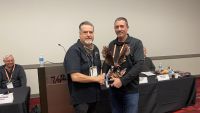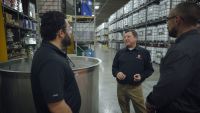Contractor to Contractor: MasonryArts, Inc.
By Masonry
Roy Swindal - MasonryArts, Inc., Bessemer, Alabama
The company began operations 50 years ago by installing heavy masonry exterior claddings; it opened as an entity on its own in 1979. Today, MasonryArts is a single-source curtain/window wall contractor for a wide variety of commercial and renovation/restoration projects. In addition to renovation work on the Pentagon in Washington, DC, MasonryArts completed a 17-story reclad for Chase-Manhattan Bank in San Juan, Puerto Rico, and is currently reglazing the Sears Tower in Chicago.
Masonry caught up with Roy Swindal just before he left for a whirlwind business trip to Europe. This is what he had to say about the masonry industry.
Masonry: What do you feel is the biggest misconception about the masonry industry?
Swindal: On the residential side, I don't think the general public understands the building materials they're using, the quality of the materials they should be using, and the actual longevity of those materials. We also have an image problem that we can't get the brickwork done, on time, and done correctly. That's incorrect.
On the commercial side, one of the first things commercial contractors do on buildings is to change to a cheaper skin ? EIFS, some type of wood, or something else ? because they think that's going to save money up front. But it doesn't save long term costs, especially for a commercial building that has a 50- to 100-year life.
Masonry: What would you do to change that misconception?
Swindal: We must develop a nationwide marketing program. We have to educate both end users and contractors ? for both residential and commercial projects ? about masonry, the inherent qualities of masonry, and that people are available who can install these products correctly.
Next, the people we're now bringing into the trade must have some pride in what they're doing. Not, "I'm going to be a bricklayer because I couldn't be a computer operator." We've got to get that pride back to "I'm a bricklayer because I enjoy working with my hands and creating walls of all types of masonry products. I make a good living. And I'm responsible."
That is a hard, hard sale.
Last, we have to police our industry. We've got to find ways to rid ourselves of unqualified contractors who are affecting our name and our ability to do this business.
Masonry: What are your three biggest concerns in keeping your company successful?
Swindal: First, quality training programs that keep good people interested. One thing I learned long ago: Young people keep your company young, growing and profitable. Training programs must be an integral part of the whole idea of us staying in business and making any money.
Second, masonry contractors must be paid on time. If not, I can't grow because I can't improve my liquidity and improve my equity. I can't get stronger because I never have enough money to operate or to do the next size job.
My third concern is the solidarity among suppliers, manufacturers, equipment producers, and masonry contractors who sell our products. We have to promote masonry products so we don't lose any more market share.
Masonry: What do you feel is the industry's biggest challenge in the near future?
Swindal: Building materials that compete with masonry products. We need to promote our products from the quality end. We're not the Yugo; we are a solid product. We are quality product. And we're one of the only products left that is installed in most cases one piece at a time, by hand.
Masonry: Where do you think the masonry industry is going to be 10 years from now?
Swindal: Because of labor shortages and the incredibly short schedules to build buildings today due to owners wanting a faster return on their money, we're going more toward unitized construction. In the past, that has been historically more expensive to do than conventional masonry.
Masonry: What do you think will be the masonry industry's biggest competitor in 10 years?
Swindal: As I was talking about in the last question, I think the masonry industry's biggest competitor will be any of the unitized, panel-type wall systems that you can take off the truck and erect on the building right then and there.
For an old, artistic, gothic church or similar project, we're always going to need good, qualified artisans who can actually put the brick up piece by piece. However, that type of work will get more and more expensive because fewer and fewer people will have that skill. This work will become a real priority for only the most exclusive work ? and for only the people who can afford it. I hate that, but I'm afraid that's where our industry is headed.
Masonry: What do you feel are the most critical issues you'll face with future government regulations?
Swindal: No question: Ergonomics. If some of the ergonomic policies that the government is discussing come to pass, they can double the cost of our work.
[The fact is] repetitive work can hurt you if you don't handle yourself right. All kinds of things can hurt you, but who doesn't have injuries? Look at football players. They don't last but 15 years, and by then they have made millions. We have many people who have been working for us as bricklayers for 45 years.
Masonry: Which group do you feel has the bigger impact on masonry's future, architects, engineers, or general contractors?
Swindal: General contractors have the number one impact on masonry's future because they are in charge. Next are the architects. They are the ones who need to stand up for masonry products when the general contractor says let's replace brick with EIFS or something else.
Actually, owners have probably the biggest impact because they hire the design/build people. However, they have to understand what the materials are and how they work. And they have to want to build a 50-year building instead of a 10-year building that they'll sell in five years.
Masonry: What do you like most about being a member of Mason Contractors Association of America?
Swindal: First, it comforts me to know that I'm not the only contractor in the country having the problems I'm having.
Second, the MCAA gives me the opportunity to listen to ideas from other companies and leaders in the masonry industry. It's good to sit down, discuss all of the problems we have, and work through solutions.
Such activity spurs new ideas in me and other people. It also helps eliminate facing a 10-year learning curve in masonry!
About the Author
Masonry, the official publication of the Mason Contractors Association of America, covers every aspect of the mason contractor profession - equipment and techniques, building codes and standards, business planning, promoting your business, legal issues and more. Read or subscribe to Masonry magazine at www.masonrymagazine.com.


















